
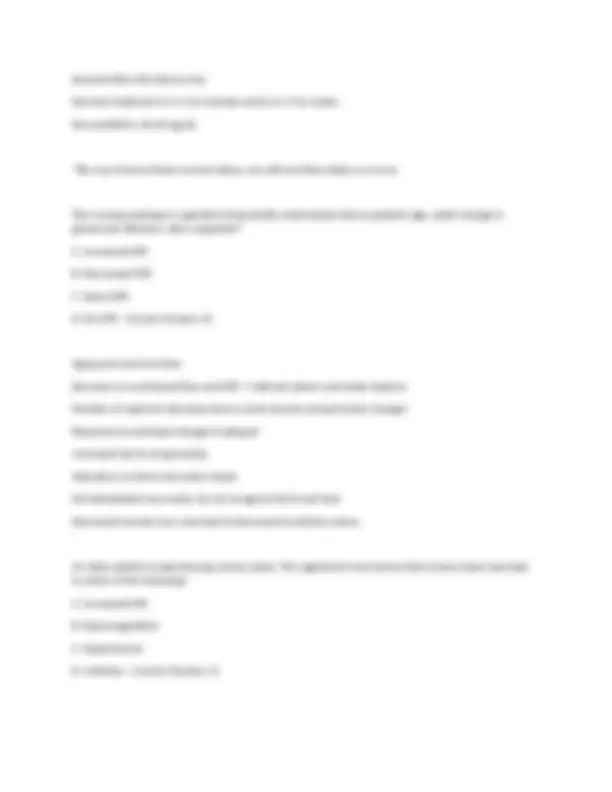
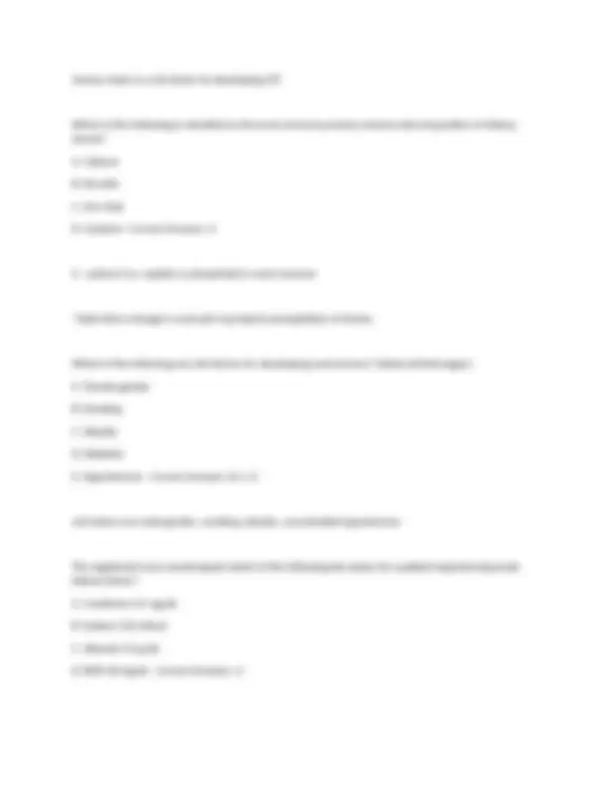
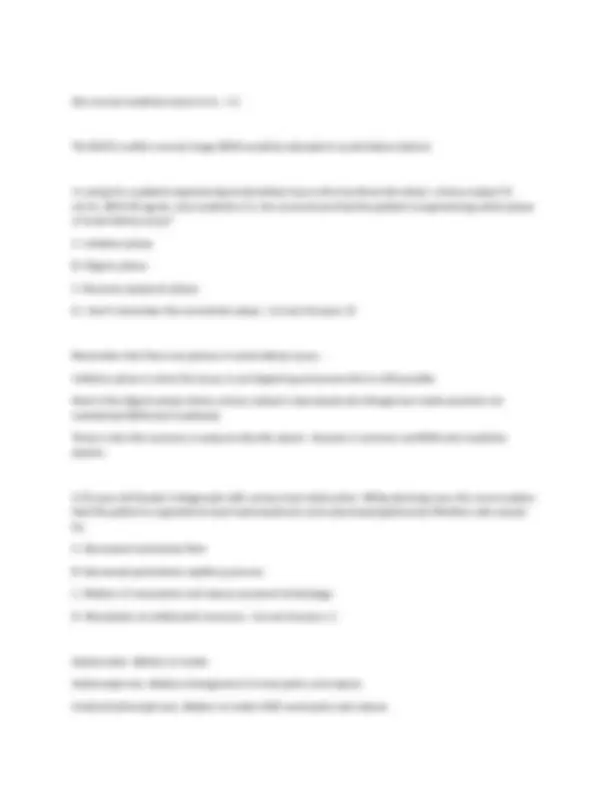

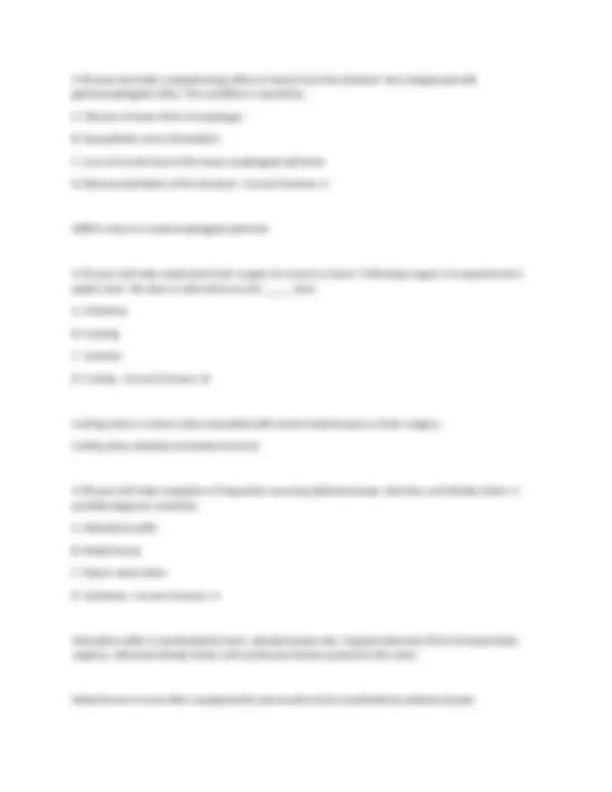
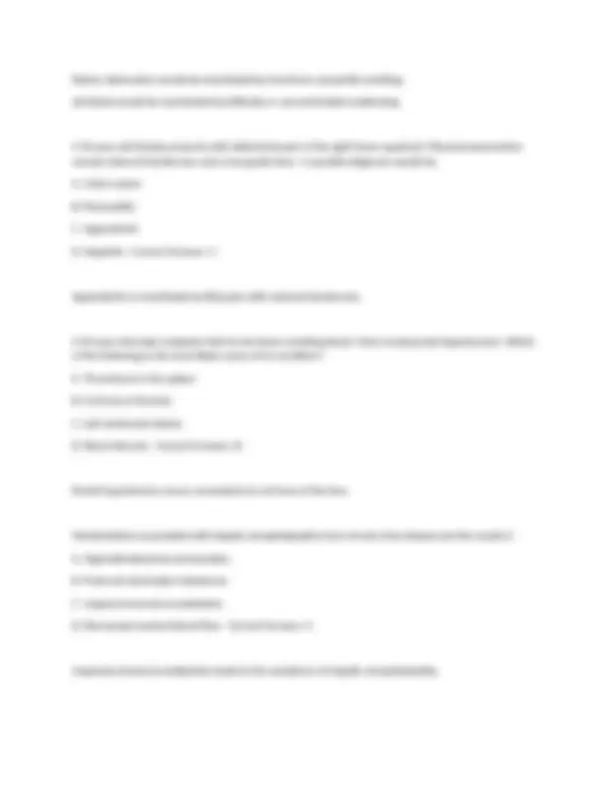
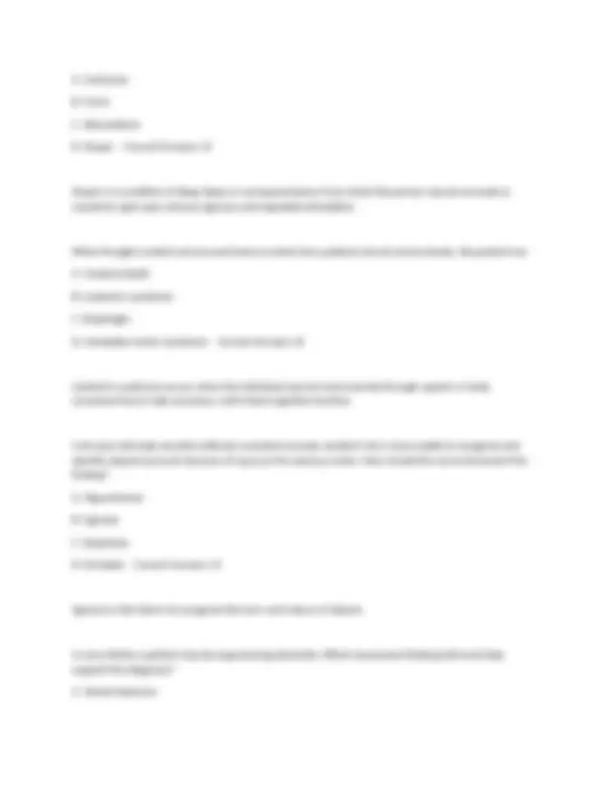
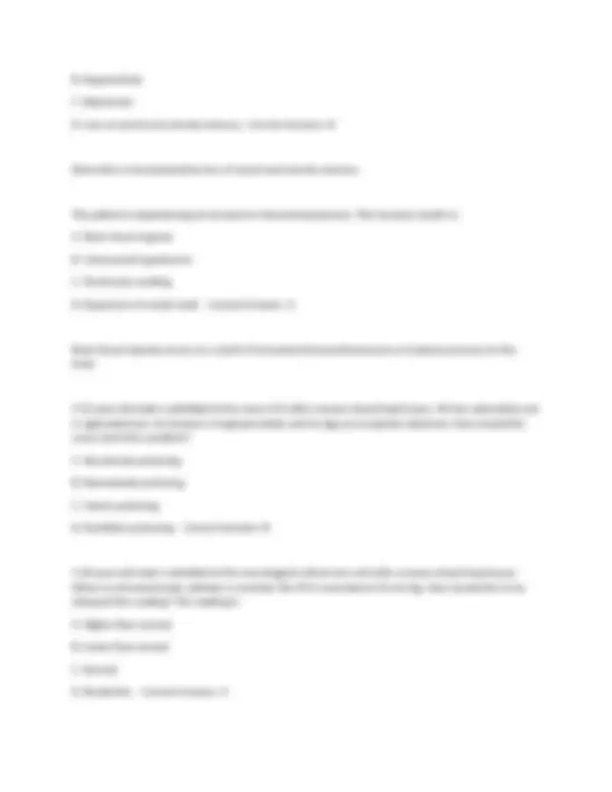
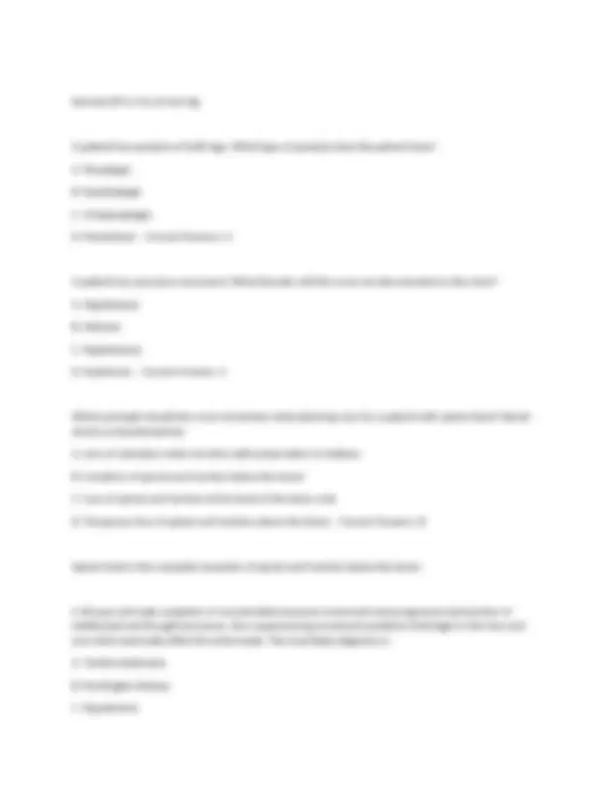
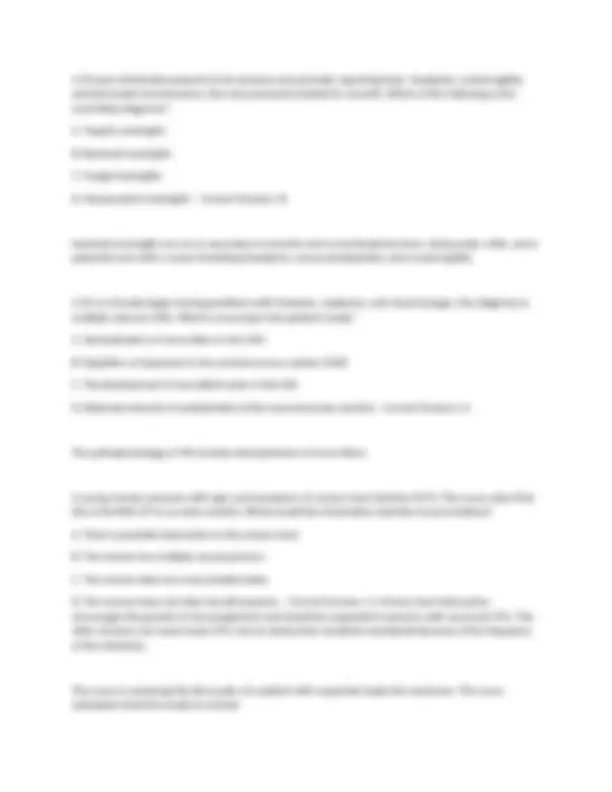
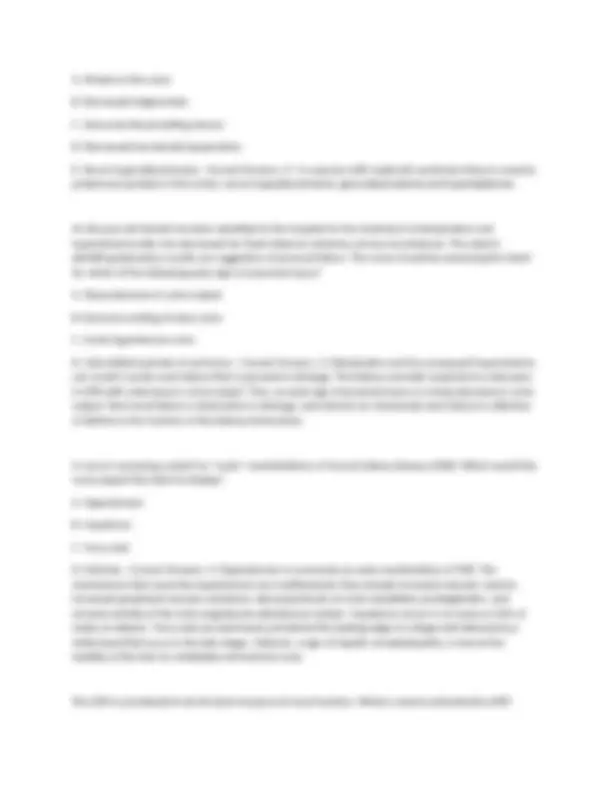
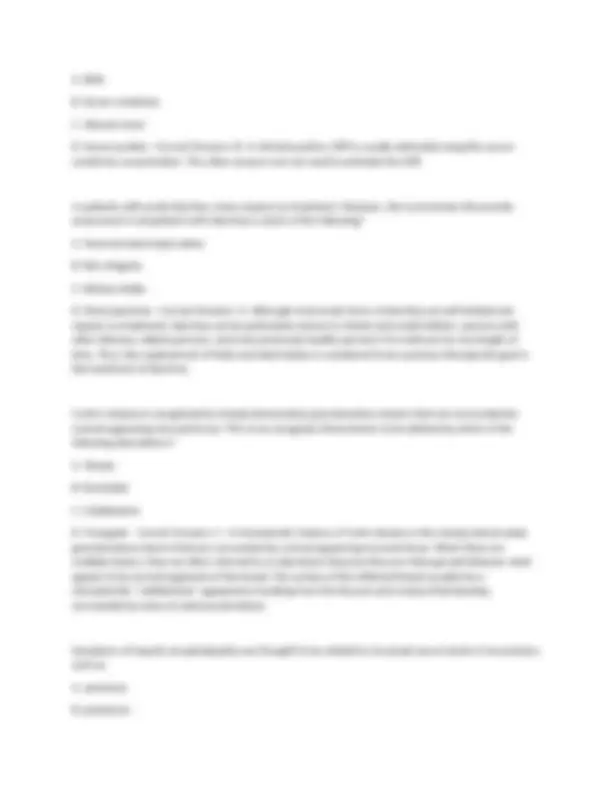
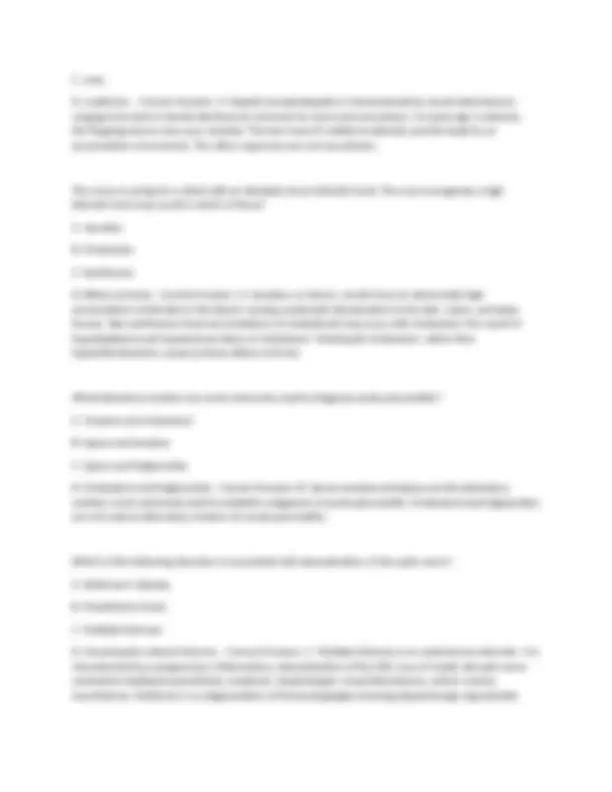
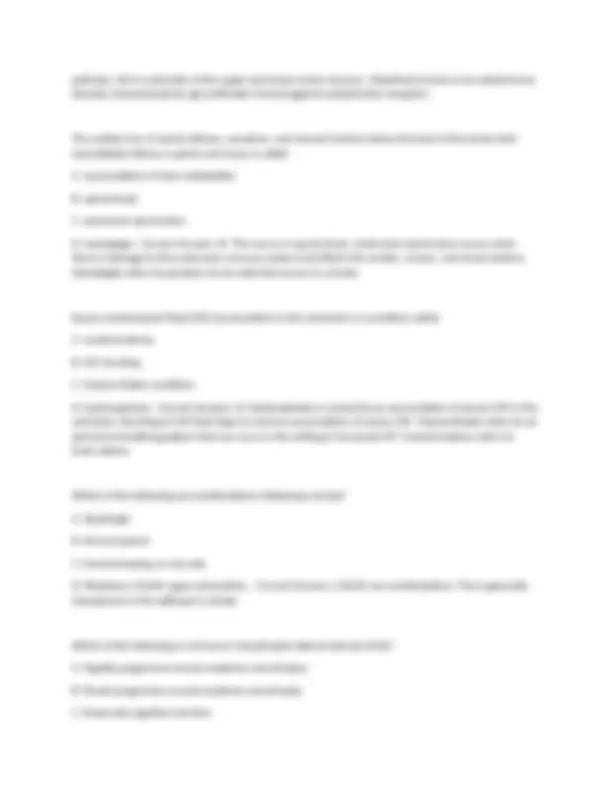
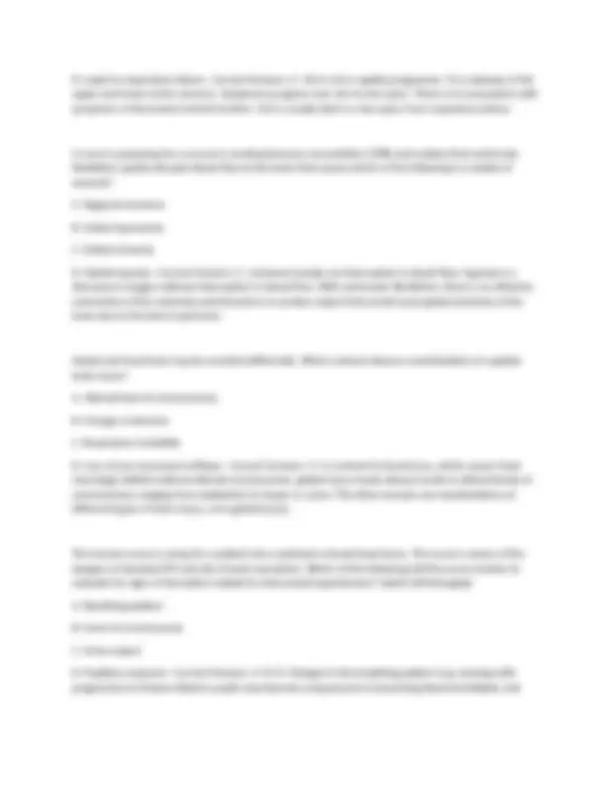
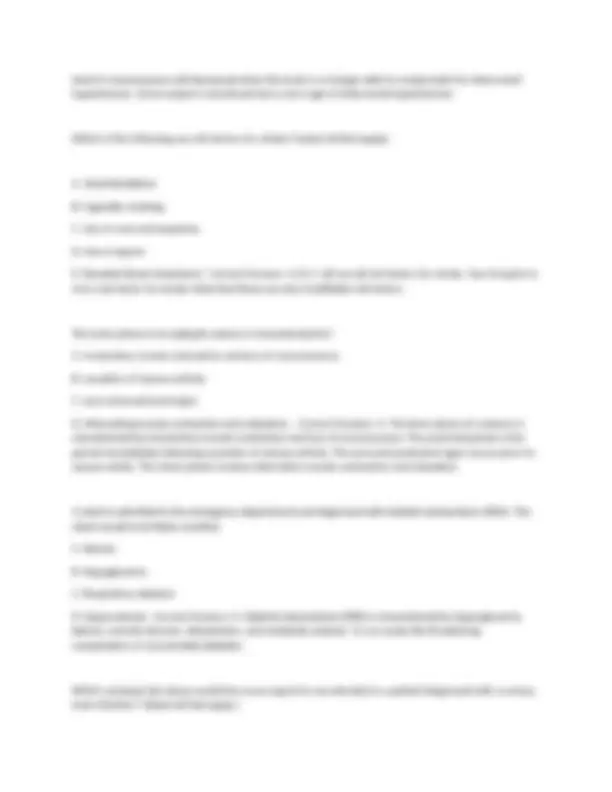
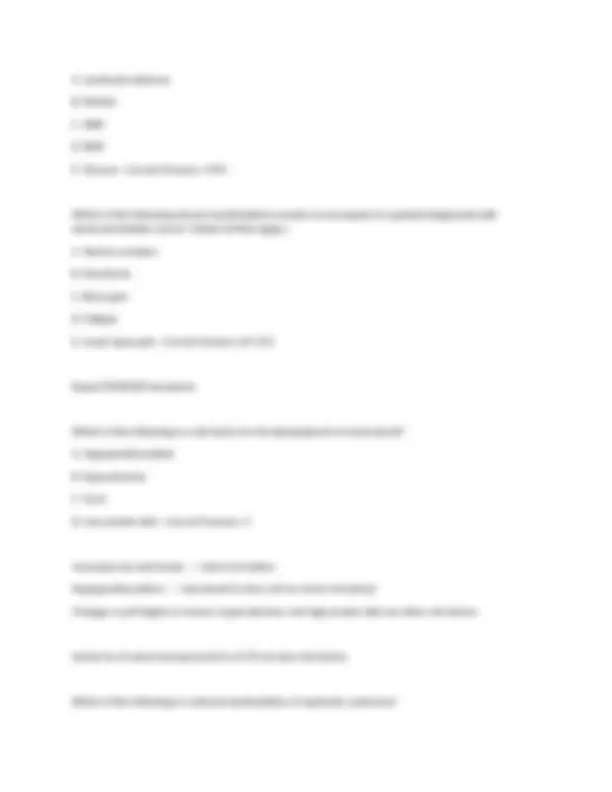
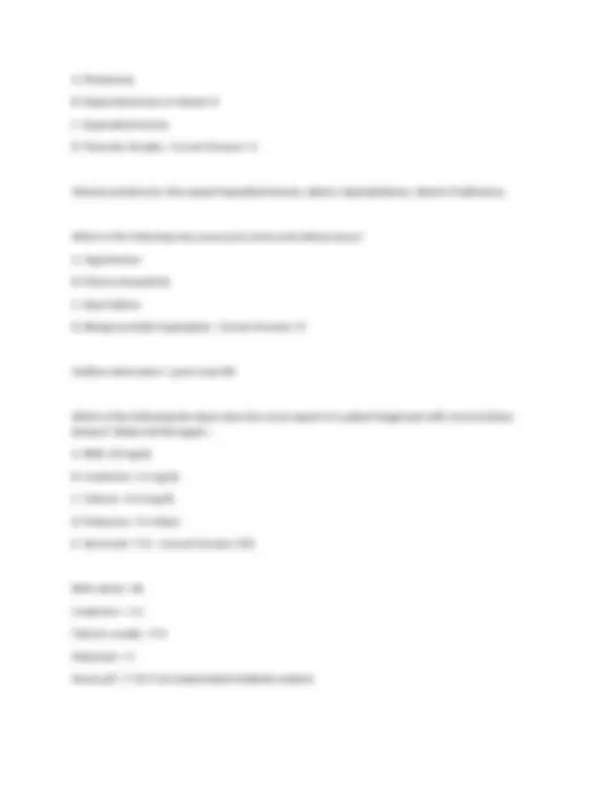
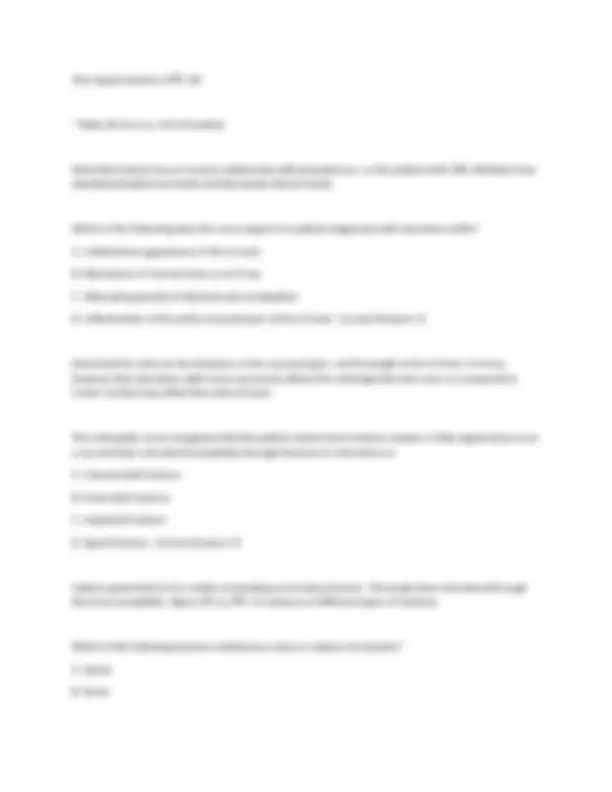
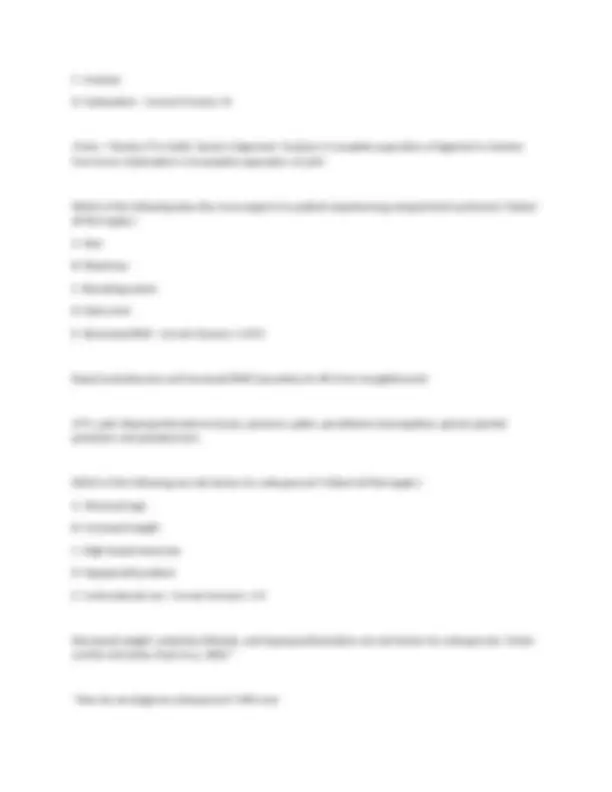
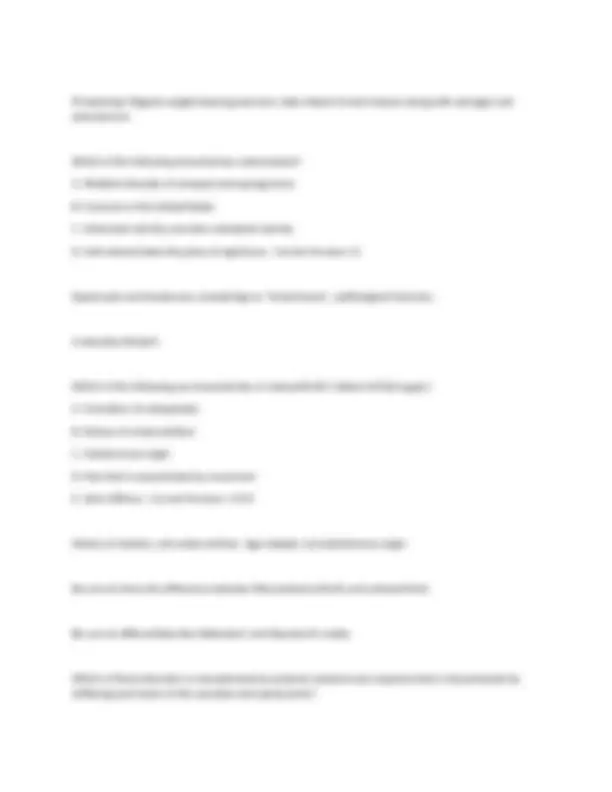
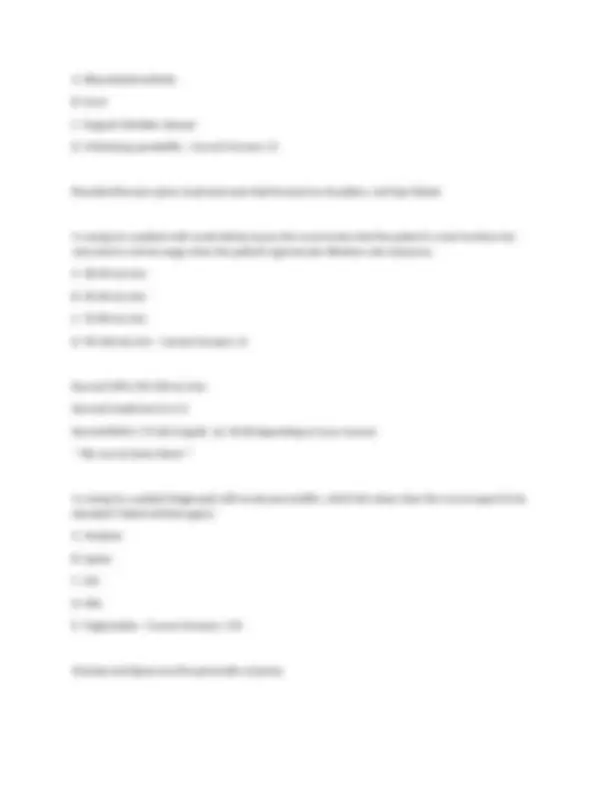
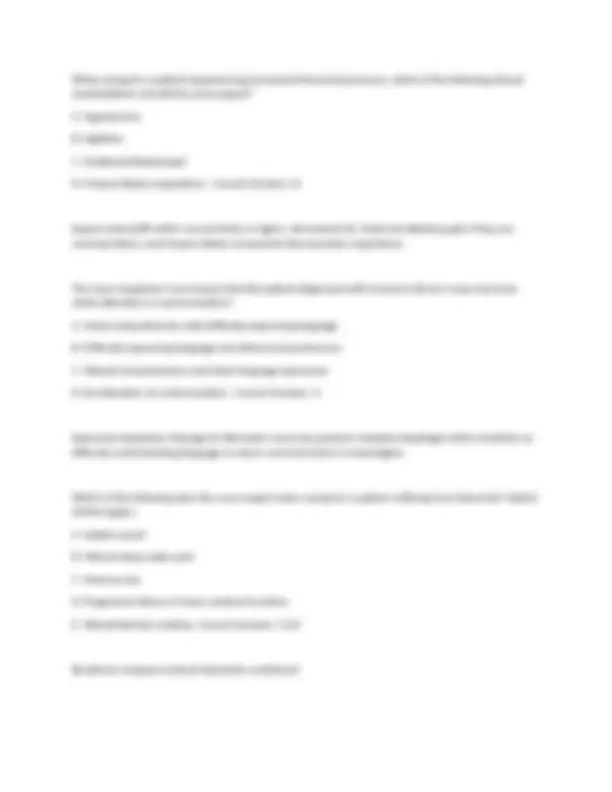
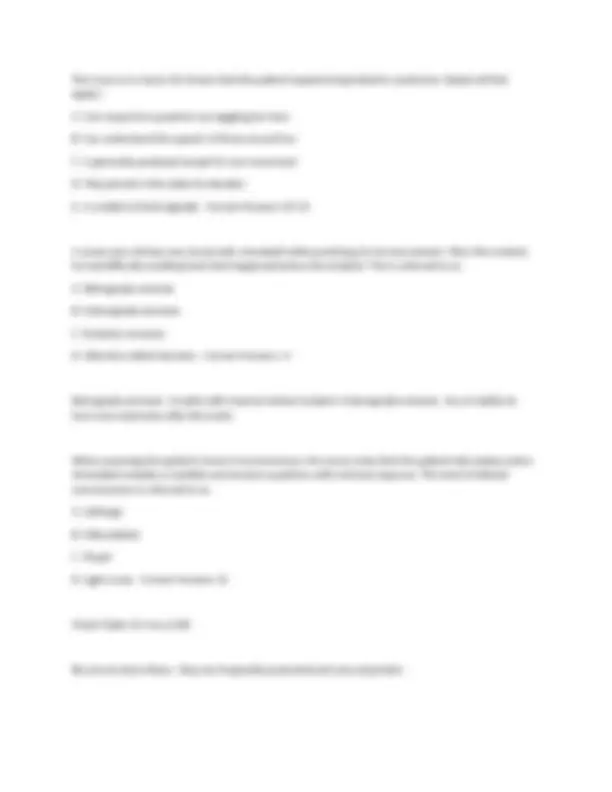
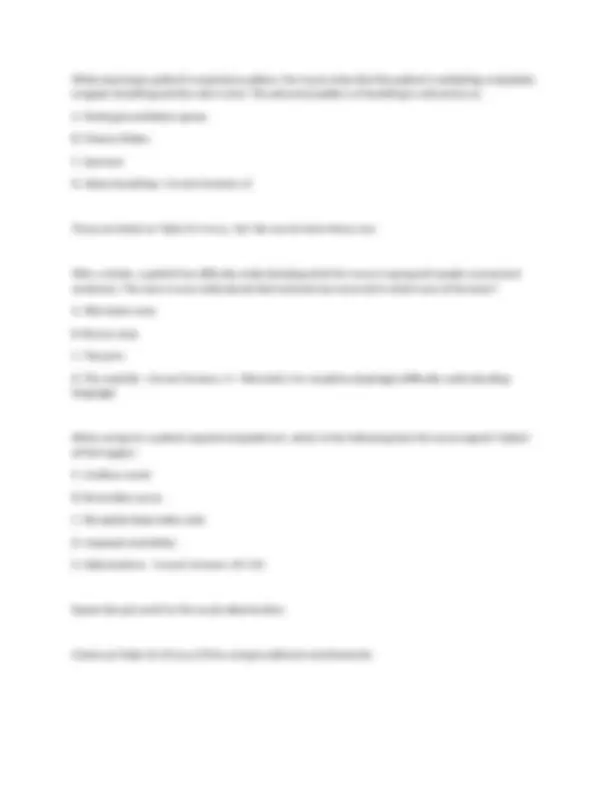
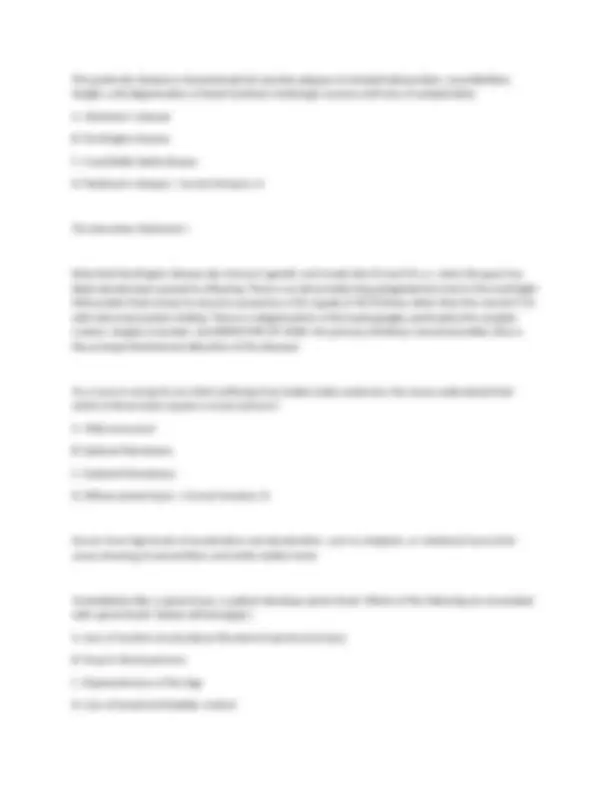
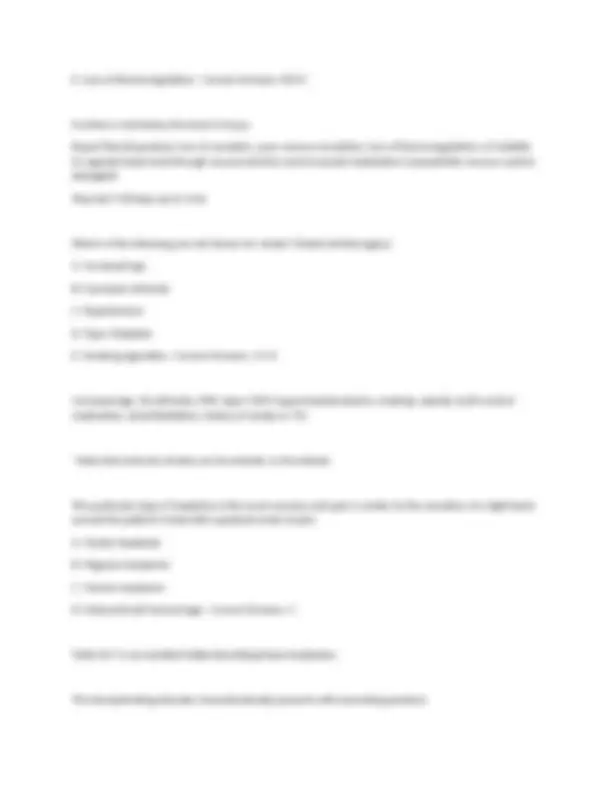
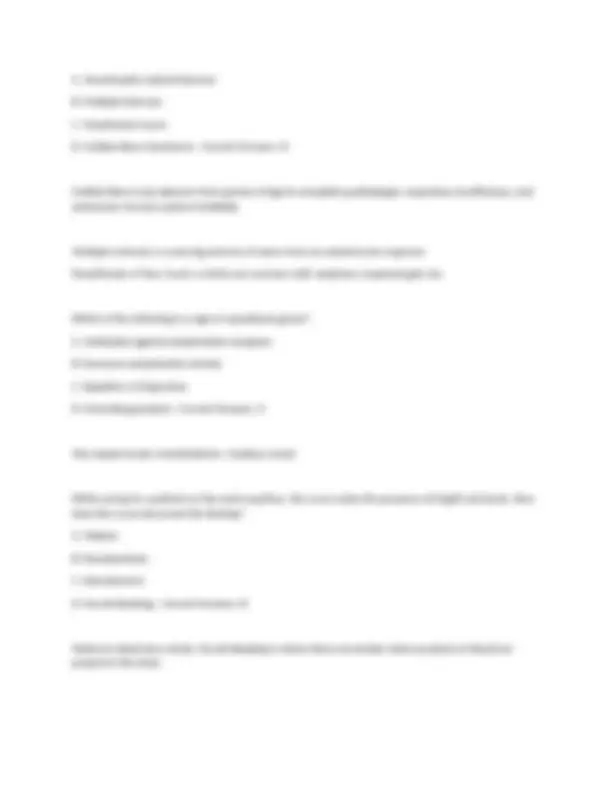
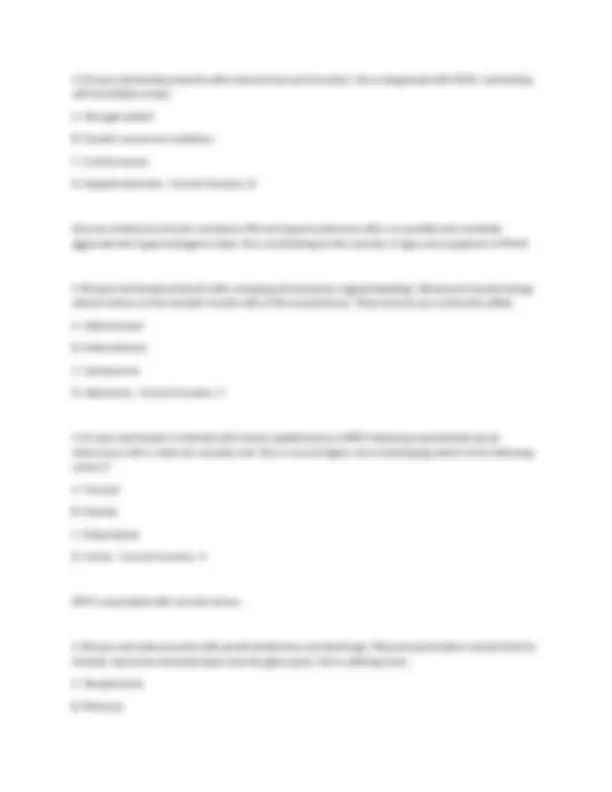
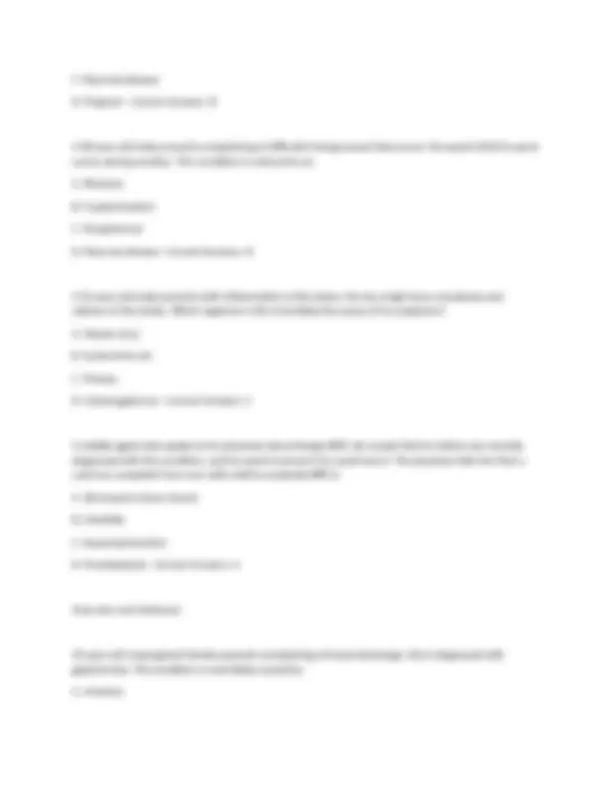
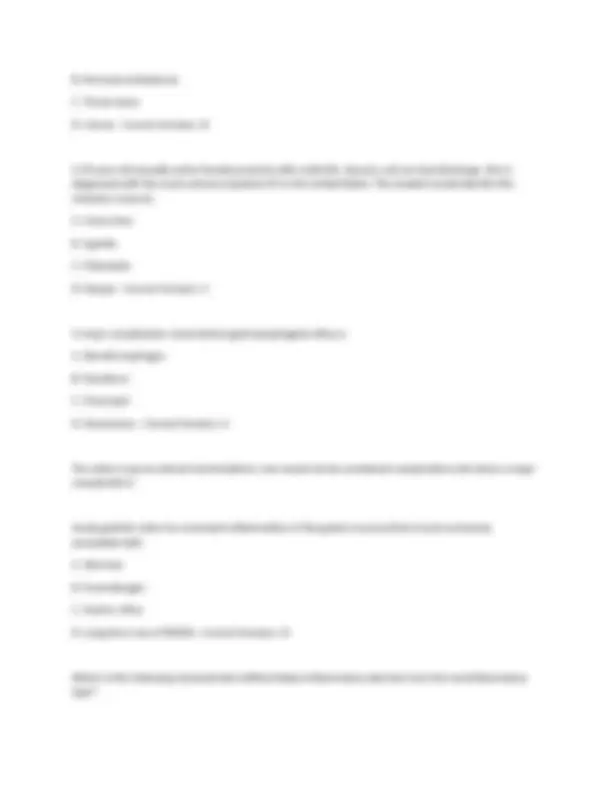
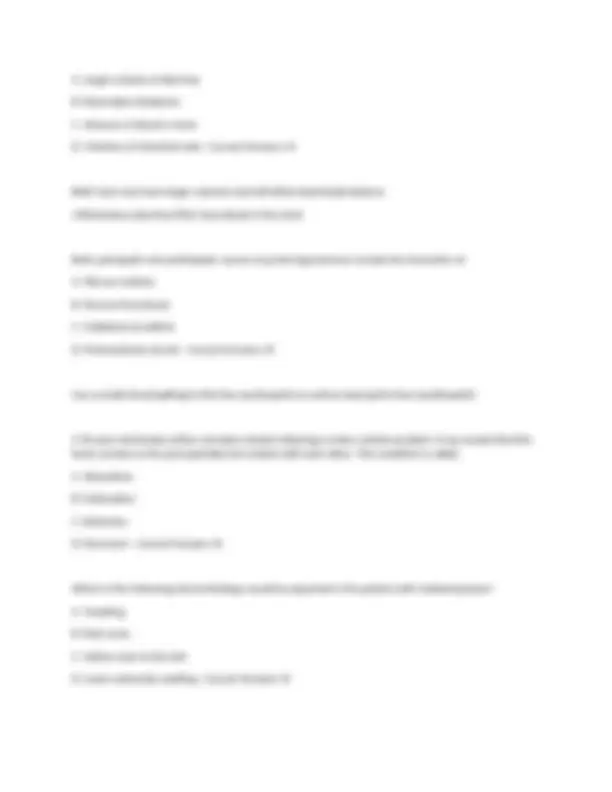



Study with the several resources on Docsity

Earn points by helping other students or get them with a premium plan


Prepare for your exams
Study with the several resources on Docsity

Earn points to download
Earn points by helping other students or get them with a premium plan
Community
Ask the community for help and clear up your study doubts
Discover the best universities in your country according to Docsity users
Free resources
Download our free guides on studying techniques, anxiety management strategies, and thesis advice from Docsity tutors
A set of practice questions and answers related to pathophysiology, covering topics such as renal function, kidney injury, urinary tract obstruction, and incontinence. It includes multiple-choice questions with explanations for correct and incorrect answers, making it a valuable resource for students studying pathophysiology.
Typology: Exams
1 / 41

This page cannot be seen from the preview
Don't miss anything!


































[COMPANY NAME] [Company address]
The nurse working in an outpatient nephrology clinic knows that which of the following are primary functions of the kidneys? (Select all that apply.) A. Production of clotting factors B. Homeostasis C. Excretion of metabolic wastes D. Regulation of acid-base balance E. Metabolism of fats - Correct Answers: B, C, D The kidneys do not metabolize fats. Production of clotting factors is a primary function of the liver. The kidneys maintain blood pressure using the RAAS and also produce erythropoietin to stimulate RBC production. In caring for a patient diagnosed with acute kidney injury, the nephrology nurse knows that which of the following tests are specific for renal function? (Select all that apply.) A. Aspartate aminotransferase (AST) B. Blood urea nitrogen C. Creatinine D. Glomerular filtration rate E. White blood cell count - Correct Answers: B, C, D AST related to LIVER function In caring for a patient with acute kidney injury the nurse knows that the patient's renal function has returned to normal range when the patient's GFR measures: A. 30-40 mL/min B. 40-50 mL/min C. 70-90 mL/min D. 90-120 mL/min - Correct Answers: D
Urinary stasis is a risk factor for developing UTI Which of the following is classified as the most common primary mineral salt composition of kidney stones? A. Calcium B. Struvite C. Uric Acid D. Cysteine - Correct Answers: A A - calcium (i.e. oxalate or phosphate) is most common *Note that a change in urine pH may lead to precipitation of stones Which of the following are risk factors for developing renal tumors? (Select all that apply.) A. Female gender B. Smoking C. Obesity D. Diabetes E. Hypertension - Correct Answers: B, C, E risk factors are male gender, smoking, obesity, uncontrolled hypertension The registered nurse would expect which of the following lab values for a patient experiencing acute kidney failure? A. Creatinine 3.5 mg/dL B. Sodium 122 mEq/L C. Albumin 3.5 g/dL D. BUN 10 mg/dL - Correct Answers: A
the normal creatinine level is 0.6 - 1. This BUN is within normal range (BUN would be elevated in acute kidney failure) In caring for a patient experiencing acute kidney injury who has these lab values: urinary output 15 mL/hr, BUN 30 mg/dL, and creatinine 3.5, the nurse knows that the patient is experiencing which phase of acute kidney injury? A. Initiation phase B. Oliguric phase C. Recovery (polyuric) phase D. I don't remember the normal lab values - Correct Answers: B Remember that there are phases of acute kidney injury - Initiation phase is when the injury is just beginning and prevention is still possible Next is the oliguric phase where urinary output is decreased and nitrogenous waste products are maintained (BUN and Creatinine) There is also the recovery or polyuric/diuretic phase - diuresis is common and BUN and creatinine decline A 25-year-old female is diagnosed with urinary tract obstruction. While planning care, the nurse realizes that the patient is expected to have hydronephrosis and a decreased glomerular filtration rate caused by: A. Decreased renal blood flow B. Decreased peritubular capillary pressure C. Dilation of renal pelvis and calyces proximal to blockage D. Stimulation of antidiuretic hormone - Correct Answers: C Hydroureter; dilation of ureter Hydronephrosis: dilation/enlargement of renal pelvis and calyces Ureterohydronephrosis: dilation of ureter AND renal pelvis and calyces
A 30-year-old male is demonstrating hematuria with red blood cell casts and proteinuria exceeding 3 to 5 g/day, with albumin being the major protein. The most probable diagnosis the nurse will see documented on the chart is: A. Cystitis B. Chronic pyelonephritis C. Acute glomerulonephritis D. Renal calculi - Correct Answers: C Two major symptoms distinctive of more severe glomerulonephritis are: hematuria with red blood cell casts (2) proteinuria exceeding 3 to 5 g/day with albumin (macroalbuminuria) as the major protein A 54-year-old female is diagnosed with nephrotic syndrome. Which of the following is a common symptom of this disease? A. Hematuria B. Dysuria C. Oliguria D. Proteinuria - Correct Answers: D Nephrotic syndrome is manifested by proteinuria Nephrotic syndrome is diagnosed when the protein level in a 24-hour urine collection is greater than 3. g A 56-year-old male presents with flank pain and polyuria. Tests reveal that he has an enlarged prostate. Which of the following types of renal failure should the nurse monitor for as it is the most likely to occur? A. Prerenal B. Intrarenal C. Extrarenal D. Postrenal - Correct Answers: D
the patient will experience postrenal renal failure due to obstruction by the prostate. What if the test revealed acute tubular necrosis? intrarenal While turning a patient with chronic renal failure, which principle should the nurse recall? Bone fractures are a risk factor in chronic renal failure because: A. Calcium is lost in the urine B. Osteoblast activity is excessive C. The kidneys fail to activate vitamin D D. Autoantibodies to calcium molecules develop - Correct Answers: C Hypocalcemia is accelerated by impaired renal synthesis of vitamin D The combined effect of vitamin D deficiency can result in renal osteodystrophies with increased risk for fractures. A man was mildly confused, and his family brought him to adult day care during the week. He was incontinent there every day until a nurse suggested that they put a picture of a toilet on the bathroom door, and he became continent. What incontinence is this? - Correct Answers: Functional Incontinence A woman has a bladder infection and is distressed to have episodes of sudden strong need to urinate that cause her to become incontinent. What incontinence is this? - Correct Answers: Urge Incontinence A woman loses a small amount of urine involuntarily every time she sneezes. What incontinence is this?
Pyloric obstruction would be manifested by forceful or projectile vomiting. Achalasia would be manifested by difficulty or uncomfortable swallowing. A 16-year-old female presents with abdominal pain in the right lower quadrant. Physical examination reveals rebound tenderness and a low-grade fever. A possible diagnosis would be: A. Colon cancer B. Pancreatitis C. Appendicitis D. Hepatitis - Correct Answers: C Appendicitis is manifested by RLQ pain with rebound tenderness. A 54-year-old male complains that he has been vomiting blood. Tests reveal portal hypertension. Which of the following is the most likely cause of his condition? A. Thrombosis in the spleen B. Cirrhosis of the liver C. Left ventricular failure D. Renal stenosis - Correct Answers: B Portal hypertension occurs secondarily to cirrhosis of the liver. Manifestations associated with hepatic encephalopathy from chronic liver disease are the result of: A. Hyperbilirubinemia and jaundice B. Fluid and electrolyte imbalances C. Impaired ammonia metabolism D. Decreased cerebral blood flow - Correct Answers: C Impaired ammonia metabolism leads to the symptoms of hepatic encephalopathy.
The icteric phase of hepatitis is characterized by which of the following clinical manifestations? A. Fatigue, malaise, vomiting B. Jaundice, dark urine, enlarged liver C. Resolution of jaundice, liver function returns to normal D. Fulminant liver failure, hepatorenal syndrome - Correct Answers: B The icteric phase is manifested by jaundice, dark urine, and clay-colored stools The liver is enlarged, smooth, and tender, and percussion causes pain; this is the actual phase of illness. A 55-year-old male died in a motor vehicle accident. Autopsy revealed an enlarged liver caused by fatty infiltration, testicular atrophy, and mild jaundice secondary to cirrhosis. The most likely cause of his condition is: A. Bacterial infection B. Viral infection C. Alcoholism D. Drug overdose - Correct Answers: C The most common cause of cirrhosis is alcoholism. While caring for a patient on a med-surg floor, the nurse notes the presence of bright red stools. How does the nurse document this finding? A. Melena B. Hematochezia C. Hematemesis D. Occult bleeding - Correct Answers: B Melena is black tarry stools Occult bleeding is where there are broken down products of blood are present in the stool
A. Confusion B. Coma C. Obtundation D. Stupor - Correct Answers: D Stupor is a condition of deep sleep or unresponsiveness from which the person may be aroused or caused to open eyes only by vigorous and repeated stimulation. When thought content and arousal level are intact but a patient cannot communicate, the patient has: A. Cerebral death B. Locked-in syndrome C. Dysphagia D. Cerebellar motor syndrome - Correct Answers: B Locked-in syndrome occurs when the individual cannot communicate through speech or body movement but is fully conscious, with intact cognitive function A 65-year-old male recently suffered a cerebral vascular accident. He is now unable to recognize and identify objects by touch because of injury to the sensory cortex. How should the nurse document this finding? A. Hypomimesis B. Agnosia C. Dysphasia D. Echolalia - Correct Answers: B Agnosia is the failure to recognize the form and nature of objects A nurse thinks a patient may be experiencing dementia. Which assessment finding will most help support this diagnosis? A. Violent behavior
B. Hyperactivity C. Depression D. Loss of recent and remote memory - Correct Answers: D Dementia is characterized by loss of recent and remote memory. The patient is experiencing an increase in intracranial pressure. This increase results in: A. Brain tissue hypoxia B. Intracranial hypotension C. Ventricular swelling D. Expansion of cranial vault - Correct Answers: A Brain tissue hypoxia occurs as a result of increased intracranial pressure as it places pressure on the brain A 51-year-old male is admitted to the neuro ICU with a severe closed head injury. All four extremities are in rigid extension, his forearm is hyperpronated, and his legs are in plantar extension. How should the nurse chart this condition? A. Decorticate posturing B. Decerebrate posturing C. Caloric posturing D. Excitation posturing - Correct Answers: B A 20-year-old male is admitted to the neurological critical care unit with a severe closed head injury. When an intraventricular catheter is inserted, the ICP is recorded at 24 mm Hg. How should the nurse interpret this reading? This reading is: A. Higher than normal B. Lower than normal C. Normal D. Borderline - Correct Answers: A
D. Alzheimer disease - Correct Answers: B Huntington disease is manifested by chorea, abnormal movement that begins in the face and arms, eventually affecting the entire body
D. Hyperactive spinal reflexes below - Correct Answers: C Six weeks ago a female patient suffered a T6 spinal cord injury. She then developed a blood pressure of 200/120, a severe headache, blurred vision, and bradycardia. What does the nurse suspect the patient is experiencing? A. Extreme spinal shock B. Acute anxiety C. Autonomic hyperreflexia D. Parasympathetic areflexia - Correct Answers: C A 72-year-old male demonstrates left-sided weakness of upper and lower extremities. The symptoms lasted 4 hours and resolved with no evidence of infarction. The patient most likely experienced a(n): A. Stroke in evolution B. AV malformation C. Transient ischemic attack D. Cerebral hemorrhage - Correct Answers: C When symptoms resolve with complete recovery, it is a transient ischemic attack A 60-year-old female with a recent history of head trauma and a long-term history of hypertension presents to the ER for changes in mental status. MRI reveals that she had a hemorrhagic stroke. What does the nurse suspect caused this type of stroke? A. Rheumatic heart disease B. Thrombi C. Hypotension D. Aneurysm - Correct Answers: D The primary causative factor of a hemorrhagic stroke is an aneurysm.
A. Protein in the urine B. Decreased triglycerides C. Abnormal blood clotting factors D. Decreased low-density lipoproteins E. Serum hyperalbuminemia - Correct Answers: A. In a person with nephrotic syndrome there is massive proteinuria (protein in the urine), serum hypoalbuminemia, generalized edema and hyperlipidemia. An 86-year-old female has been admitted to the hospital for the treatment of dehydration and hyponatremia after she decreased her fluid intake to minimize urinary incontinence. The client's admitting laboratory results are suggestive of prerenal failure. The nurse should be assessing this client for which of the following early signs of prerenal injury? A. Sharp decrease in urine output B. Excessive voiding of clear urine C. Acute hypertensive crisis D. Intermittent periods of confusion - Correct Answers: A. Dehydration and its consequent hypovolemia can result in acute renal failure that is prerenal in etiology. The kidney normally responds to a decrease in GFR with a decrease in urine output. Thus, an early sign of prerenal injury is a sharp decrease in urine output. Post-renal failure is obstructive in etiology, and intrinsic (or intrarenal) renal failure is reflective of deficits in the function of the kidneys themselves. A nurse is assessing a client for early manifestations of chronic kidney disease (CKD). Which would the nurse expect the client to display? A. Hypertension B. Impotence C. Terry nails D. Asterixis - Correct Answers: A. Hypertension is commonly an early manifestation of CKD. The mechanisms that cause the hypertension are multifactorial; they include increased vascular volume, increased peripheral vascular resistance, decreased levels of renal vasodilator prostaglandins, and increase activity of the renin-angiotensin-aldosterone system. Impotence occurs in as many as 56% of males on dialysis. Terry nails are dark band just behind the leading edge of a fingernail followed by a white band that occur in the late stages. Asterixis, a sign of hepatic encephalopathy, is due to the inability of the liver to metabolize ammonia to urea. The GFR is considered to be the best measure of renal function. What is used to estimate the GFR?
B. Serum creatinine C. Albumin level D. Serum protein - Correct Answers: B. In clinical practice, GFR is usually estimated using the serum creatinine concentration. The other answers are not used to estimate the GFR. In patients with acute diarrhea, many require no treatment. However, the nurse knows the priority assessment in all patients with diarrhea is which of the following? A. Fluid and electrolyte status B. Skin integrity C. Dietary intake D. Stool specimen - Correct Answers: A. Although most acute forms of diarrhea are self-limited and require no treatment, diarrhea can be particularly serious in infants and small children, persons with other illnesses, elderly persons, and even previously healthy persons if it continues for any length of time. Thus, the replacement of fluids and electrolytes is considered to be a primary therapeutic goal in the treatment of diarrhea. Crohn's disease is recognized by sharply demarcated, granulomatous lesions that are surrounded by normal-appearing mucosal tissue. The nurse recognizes these lesions to be defined by which of the following descriptions? A. Mosaic B. Pyramidal C. Cobblestone D. Triangular - Correct Answers: C. A characteristic feature of Crohn disease is the sharply demarcated, granulomatous lesions that are surrounded by normal-appearing mucosal tissue. When there are multiple lesions, they are often referred to as skip lesions because they are interspersed between what appear to be normal segments of the bowel. The surface of the inflamed bowel usually has a characteristic "cobblestone" appearance resulting from the fissures and crevices that develop, surrounded by areas of submucosal edema. Symptoms of hepatic encephalopathy are thought to be related to increased serum levels of neurotoxins such as: A. ammonia B. potassium.